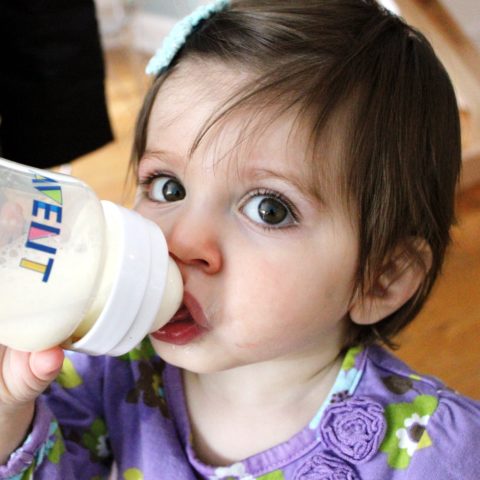
This post is sponsored by the Robert Wood Johnson Foundation but all opinions are my own.
When I was a toddler, I did not like milk. I still don’t. But back then, because there weren’t definitive guidelines around what babies should and shouldn’t drink, my parents gave me apple juice. I drank apple juice like it was water. People in the ’70s just thought fruit juice was healthy and they didn’t really put any limitations on it. I sometimes wonder if all that apple juice really strengthened my sweet tooth.
After I got sick of apple juice, I moved onto orange juice. I would drink huge glasses of it. I remember whenever we would go to my grandmother’s house, I could never understand why she would give me orange juice in these teeny tiny juice glasses. Now I get it. As an adult, I can’t drink more than a few sips of orange juice. I love the taste, but too much gives me a stomach ache and acid reflux.
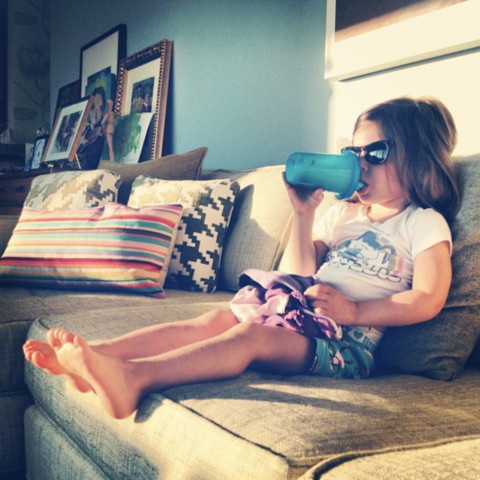
When my kids were little, the only drinking guidelines we had was whatever our pediatrician told us. With Mazzy, I breastfed for as long as I could (I kept it up for year) and supplemented with formula when necessary (at about six months.) Then she started drinking cow’s milk. Mazzy loved drinking milk. She drank so much of it, we had to ask our pediatrician if it was too much. Our doctor told us to keep it just one cup in the morning, which was a process of weaning off. If you’ve been following me for a long time, you might be remember “nice and warmy milky.” That was what Mazzy called her morning milk. In the beginning we gave her cold milk, but then she stayed with my mom for a weekend and Grammy warmed it up for her. Mazzy wouldn’t go back to cold milk after that. She needed her “nice and warmy milky” first thing every morning, like adults need their cup of coffee. And she had to have it in a very specific cup.

It was the “nice and warmy milky” that made it hardest for us to travel when she was little. We needed to bring the cup, which was no big deal, but we also needed to figure out a way to warm it, right when she woke up. When that was impossible, we needed to convince her to get up, get dressed and go down to breakfast, all before she had her milk. That was HARD. Then we could never get the restaurant to heat up the milk to the right temperature. It was always too hot. And then once it cooled (waiting was Mazzy’s version of torture), it never tasted right to her. I can’t tell you how many times we relived this same scenario.
Harlow was completely different. I breastfed up until she was about nine months, supplemented with formula and then switched to cow’s milk when she was a year old. When we switched from a bottle to a cup at around the same time, she wanted nothing to do with milk. She was tiny so this was a problem. We could not get her to drink it. The pediatrician told us to find other means to up her dairy intake, like feeding her yogurt, butter, and ice cream. I remember the first time we gave her ice cream, I laughed that it was doctor’s orders! I think that was the first time Mazzy had ice cream too.
Now Harlow is huge fan of water, while Mazzy will always chose juice, if given the choice. But she’s pretty good about water too. I’ve adopted my grandma’s tiny servings of orange juice for Mazzy in the morning. Or I will mix with water. My kids love Shirley Temples and lemonade, but we restrict those “special drinks” to dinners out at a restaurant and special occasions. We never drink soda. I never drank soda as a kid (my mom never had it in the house) and as an adult, I really don’t like it, so I’m hoping when and if my kids ever try it, they will feel the same. In fact, if my kids spot their dad drinking soda (which usually happens when we go out for pizza), they react as if he were smoking a cigarette.

Recently, the Academy of Nutrition and Dietetics, the American Academy of Pediatric Dentistry, the American Academy of Pediatrics and the American Heart Association all came together for the first time to come up with one consistent guideline for beverage consumption for children ages 0-5. They convened an expert panel and a scientific advisory to review all the present research to come up with a consensus on their recommendations. Their message to pediatricians and new parents is that “it is critically important to establish healthy patterns in early childhood to prevent future health issues, like dental cavities or diet-related diseases like obesity and type 2 diabetes, and to ensure optimal development and overall health.”

We didn’t have approved beverage guidelines when my kids were little, but I hope I did okay with their intake to help set them up for healthy habits for the rest of their life!
Approved Beverage Consumption Guidelines, Kids 0-5yo
1) All kids 5 and under should avoid drinking flavored milks (e.g., chocolate, strawberry), toddler formulas, plant-based/non-dairy milks (e.g. almond, rice, oat)*, caffeinated beverages (e.g. soda, coffee, tea, energy drinks) and sugar- and low-calorie sweetened beverages (e.g. “diet” or “light” drinks, including those sweetened with stevia or sucralose), as these beverages can be big sources of added sugars in young children’s diets and provide no unique nutritional value.
2) Babies 0-6 months need only breast milk or infant formula.
3) Babies 6-12 months, in addition to breast milk or formula, offer small amounts of water once foods are introduced.
4) Toddlers 12-24 months: Whole Milk, water and small amount of 100% fruit juice to avoid added sugars (fruit is preferred). No more than 4 oz of 100% fruit juice per day.
5) Children 2 – 5 years old: Milk (skim or 1%) and water, small amounts of 100% fruit juice (diluting it with some water is a good approach). No more than 4 oz of 100% fruit juice per day for 2-3 year olds. No more than 4-6 oz of 100% fruit juice per day for 4-5 year olds.
The research shows that what children drink from birth through age five has a big impact on their health – both now and for years to come. Hopefully, these guidelines can help set children on a path for healthy growth and development. As always, consult with your health care provider about your child’s individual needs (specific diets, allergies, intolerances, etc).
If you want a handy graphic of the new guidelines to print out and put on your fridge, here you go!
You can learn more about the new guidelines at healthydrinkshealthykids.org.














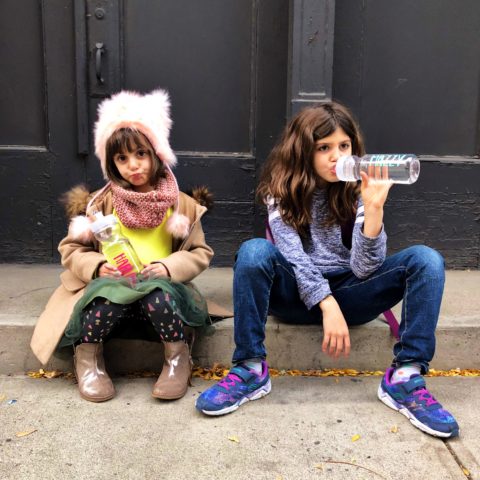
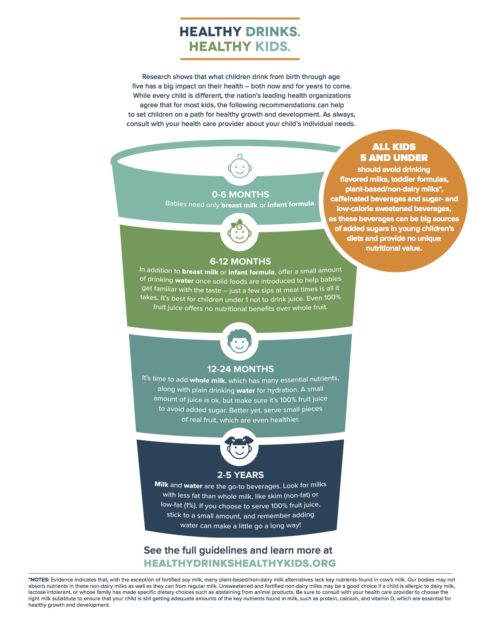
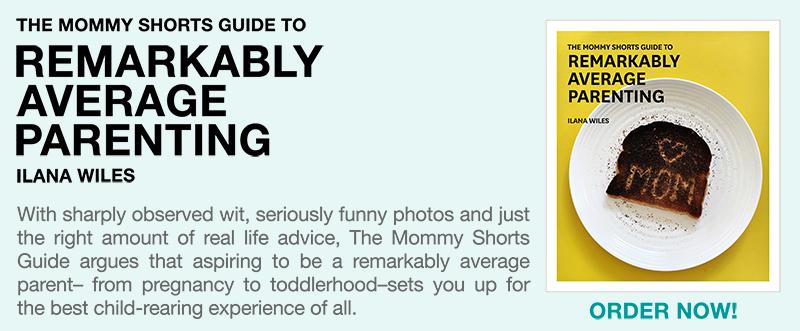




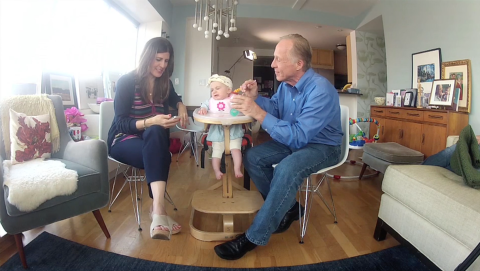






Thank you for sharing this! It is such helpful information, and I don’t know how parents are expected to find all these types of things on their own.
My kids hardly ever have juice or soda. My older kids do love it, but we just don’t keep it in the house, so it’s really more of a special occasion thing. My 17 month old has only ever had milk or water. My older girls love milk and water, so I feel good about this, since that’s what we do anyway! I have always been really consistent about my kids drinking water and I think that has just made it “normal” for them to drink it most of the time.